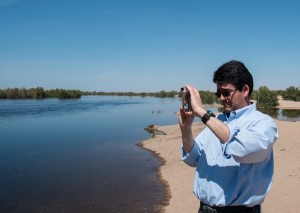We’re devoting a lot of attention in the Colorado River Basin to preventing “shortage”, which will happen if Lake Mead enters any given year below elevation 1,075. The discussions are around a new “Drought Contingency Plan” that would reduce water use in the basin, heading off the risk of 1,075 (now at a one in three chance for 2018, though that calculation was done before the latest round of Upper Basin snow).

Deputy Interior Secretary Mike Connor at the San Luis Bridge, March 28, 2014, watching the delta pulse flow
But the real risk is not 1,075, it’s really 1,025. Under the current operating rules, we could drop from 1,075 to 1,025 in a hurry, and at that point we’d be very close to a system crash in which lots of people don’t get water. As former Deputy Secretary of the Interior Mike Connor pointed out in a 2014 interview with me, the real risk is when Lake Mead drops to levels so low that the risk of catastrophic shortages is high and we lack the rules to deal with it. Here’s the scene from my book:
As we turned from the river to ferry Connor back to the Yuma airport for his flight home, the talk turned to the serious next steps. At that time, the Bureau of Reclamation’s internal modeling efforts showed the potential for drought and climate-change trouble ahead. As Lake Mead drops, rules kick in that require water users in Nevada, Arizona, and Mexico to remove less water from the system each year. But those reductions are modest, and Connor told me that the Bureau’s worst-case modeling showed that even with the agreed-upon reductions, Lake Mead could quickly drop past a point of no return, to levels at which the current rules would be no help in determining who was entitled to how much.
Connor, who since leaving Interior at the end of the Obama administration has been named a Walton Family Foundation Environment Program Fellow, explained it this way in an interview published last week:
People will start to get nervous because there is not a plan in place on how to manage water allocation in the lower Colorado River if Lake Mead drops to critically low levels below 1,025 feet. The potential for a very sharp decline in lake levels will unsettle everyone.
The thing is, the near term actions being taken in the Drought Contingency Plan to reduce the risk of a 1,075 shortage will also help establish a framework to manage much lower levels, by reducing water use by all the states of the Lower Basin.
A good snowpack in the Rockies has reduced the risk. But it has not gone away.
